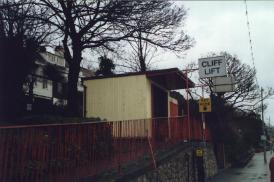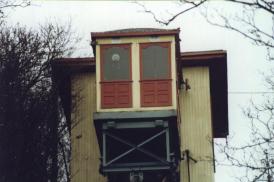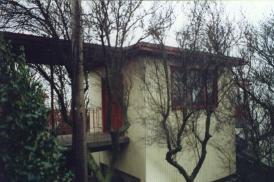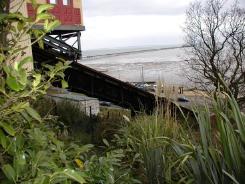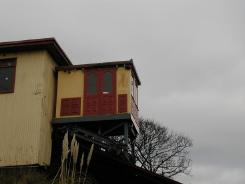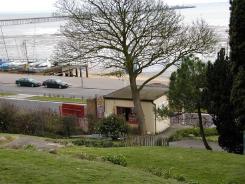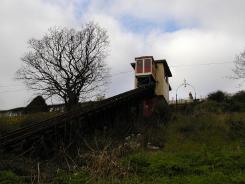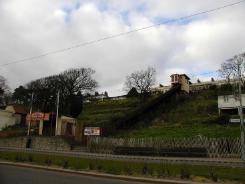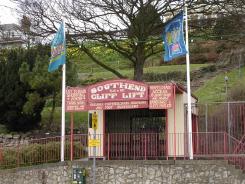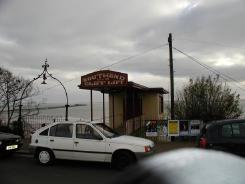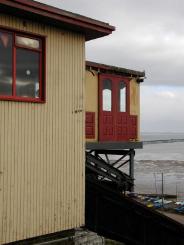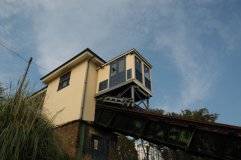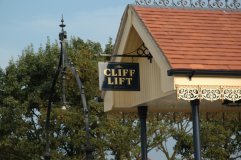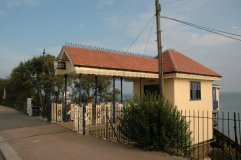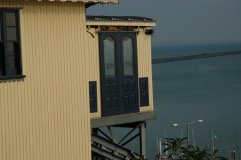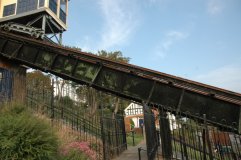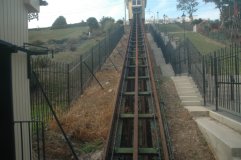Southend Cliff Railway
This single line was constructed in 1912. Though having only a single car the railway is a true counterbalanced funicular. It has a counterweight running on a 1ft 9in gauge track, underneath the 4ft 6in gauge running track. The lift is currently undergoing a full restoration and should open this summer.
Update June 2010 By Nick Skinner used here with his kind permission
The site of the Cliff Lift was originally occupied by moving public walkway which opened in 1901, it was built by the American engineer Jesse Reno. This was called “Reno’s Electric Stairway” when it opened it was unique in the country as other town had built Cliff Lift’s. The contraption at Southend was the forerunner to the modern day escalators.
This was basically wooden slatted steps attached to a looped chain, driven by a diesel engine with very little safety measures in place, however no accidents were ever reported.
The biggest draw-back to the facility was the fact there was no cover from the elements, it also proved noisy, uncomfortable and was very unreliable regularly needing to stop for maintenance work to be undertaken so a replacement was needed.
The current cliff lift was built by Waygood & Company in 1912, opening on August bank Holiday the same year.
It is a single track twin gauge counterweight rack railway. The car runs on an elevated 4 foot 6 inch gauge track with the counterweight running on a 1 foot 9 inch gauge track below the car track. The length of the railway is 130 feet (40 meters) climbing from the seafront to cliff top rising 57 feet (17 meters) with a gradient of 43.4% (1 in 2.28). The car could carry 18 people at a time, the traction was supplied by electric motors.
The first major refurbishment of the railway came in 1930, this saw the car replaced whilst being in keeping with the original design the new car had room for 30 people, a general refurbishment of the whole railway was also undertaken.
Ever since it had opened only basic stations were provided at the top and at the bottom of the cliffs during a major refurbishment program in 1959 it was decided to construct proper stations with covered waiting facilities including seating and lift call buttons. During the refurbishment the car was also sent away for a new one to be constructed.
The Cliff Lift remained popular and well used for the next thirty years, then in 1990 with the Cliff Lift reaching 78 years old another in-depth restoration began. This saw the car again being rebuilt (for the third time) with the most notable change being to the layout of the doors.
The original car was built in 1912, the first replacement of 1930, and the second replacement of 1959 had all had entry/exit doors to the front & rear of the car, the 1990 replacement kept the rear door but had a door to the right hand side this reduced capacity to 18 and also necessitated modifications to the seafront station, externally the car is still more or less aesthetically the same as the original 1912 car.
With a major fault occurring on the Cliff Lift in 2004 the council decided to carry out a major restoration on the 92 year old railway.
After applying to the National Lottery later 2004 Southend Council was awarded £1.5 million of Heritage Lottery Funding for the restoration of the Cliff Lift and Cliff Gardens. Work on restoring the stations commenced in October 2005 but with the restoration of the two stations progressing well a major setback hit the project when the European Union decided to change the designation of the rack railway re-listing it as a cable car.
With the designation change the much stricter legalisation of operating a cable car needed to be met, this saw big delays hit the restoration program as all the new safety implementations and changes to the operating and breaking systems needed to be specially designed and built as a unique one off items, these also had to be in keeping with the style of listed Cliff Lift.
During this delay it was decided to remove further sections of the Cliff Lift for inspection deep inside the structure. After removal of certain sections of the superstructure it was found that parts deep inside the inner structure has corroded and would need to be replaced.
The restoration of the two stations was completed in April 2006 at a cost of £133,000. This saw the flat roofs replaced by Victorian style pitched roofs and the lower stations ramp reduced in angle to make it more disabled/buggy friendly.
The money to restore the Cliff Lift did not allow for any work on the mechanical side of the restoration or for any works relating to the change of designation.
In 2007 Southend Borough Council allocated set aside £300,000 from its Capital Programmes fund to fund the works needed to bring the Cliff Lift back into operation.
In 2008 the Cliff Lift the landmarks track way was “gift wrapped”, this saw a scaffold erected around it this was then wrapped in heavy duty tarpaulins, this was to stop any more damp weather attacking the exposed inner elements of the structure it also allowed the restoration crews to work in any weather conditions inside the tented structure.
In 2009 it was the turn of the car to begin restoration, it was carefully lifted from the track and placed on to a specially adapted low-loader so that the load remained balanced and did not put any stress on the antique car.
The rebuilt car returned to Southend on Monday 22nd March 2010 the body of the car was completely rebuilt to comply with all current disability laws the cost of restoring the car totalled £650,000. It was returned to the rails the following day. The body is new build whilst the cassis is the original one from the railway.
The Cliff Lift was re-opened by the Mayor of Southend on Tuesday 25th May 2010. The first major use of the restored Cliff Lift was the Southend Air Festival just five days later.
A lift attendant is in the car during operating hours, a call button is located in each of the stations for the public to notify the attendant that it is needed.
The fare is 50p a ride, opening times are from 10:00am—5:45pm Monday to Sunday.
During the 2006 Restoration
| Date Opened | ?/8/1912 | Length | 40 m |
| Gradient | 1:2.3 | Track Gauge | 1372 mm |
| Number of Cars | 1 | Open to Public | Yes |
| Funicular Type |  | Track layout |  |
| Power Source |  | Railway Status |  |
